We’re in Colombia with Rob Smith of "Wild About Colombia" on a mission to find some of the country’s rare and endemic primates. On our first leg we found 10 species (see our previous blog post) and we expected more in this trip segment. On December 13 we flew from Bogota to Puerto Asis in the south close to the border with Ecuador. We checked into our hotel right across the street from the airport and had lunch. Later that afternoon, we were met by Diego, our local guide, for a short boat ride across the Putumayo River to a village where we hoped to see some different monkeys.
We soon spotted our first primate in this new area, an Ecuadorian Squirrel Monkey, another subspecies of Humboldt’s Squirrel Monkey. We continued past village houses and a school to a cow pasture but didn’t encounter any more monkeys. We started to head back when Diego heard tamarins! They were Black Mantle Tamarins, new to the trip but not a lifer.
We returned the way we had come to look for our next quarry, the Red Titi Monkey, on the other side of the village. We encountered barking village dogs and cows that blocked the path but no titis. We headed back to the area where we had seen the tamarins but now the trees were empty. Suddenly a woman from the village shouted that they had found the titis! Sure enough, not far from where we had docked the boat was a family of 4 Red or White-tailed Titi Monkeys including a mom with a very young baby. We had just walked 3.5 miles and the titis were right by our boat!
We left early the next morning toward the town of Mocoa and our next destination the Donde se Oculta el Sol Nature Reserve. We were greeted by the manager, Corentin who gave us a brief history of the 70-hectare reserve. The current owner acquired the property 20 years ago from the government and gave it to her to relocate from a conflict area. Twelve years ago, the owner decided to conserve the forest rather than clear it for farming and 5 years ago she started an ecotourism project. There are 8 species of primates in the reserve and we set off after breakfast to see how many we could find.
 |
| Donde se Oculta el Sol Nature Reserve |
We climbed up a steep hill and into the forest. Last night’s storm had left the trail wet and slippery and there were a few downed trees to get around. Possibly due to the storm, the monkeys didn’t vocalize this morning so Corentin had no idea where they were located. We continued to climb finally reaching a more level ridge. We veered off onto a trail good for Miller’s Saki but found none. Corentin knew a tree with a Spix’s Night Monkey nest, so we climbed down to investigate. No one was home. We hiked back up toward the main trail. It had now been 2 hours without any trace of a monkey. Finally, one was spotted in the canopy, a Miller’s Saki we were told. We tried to follow it to get a better view. I managed to get a brief look to confirm it was a saki but Marc was unable to get a photo.
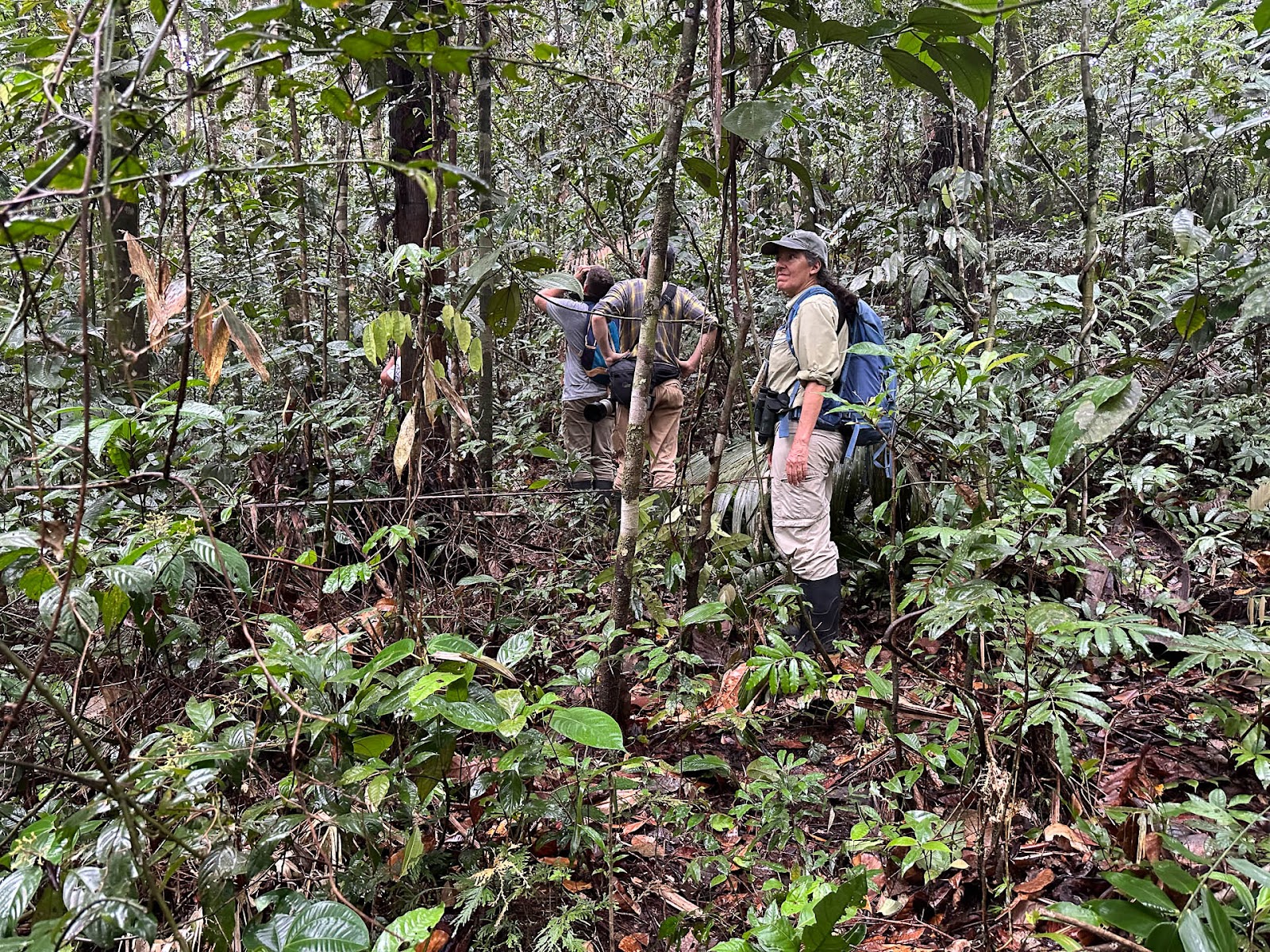 |
| Searching for Miller's Saki |
The monkey moved off and we continued on. Finally, we heard titis vocalizing in the distance and we headed in their direction. Their calls grew louder but stopped as we approached so we couldn’t find them. Foiled again! Corentin knew of another location for the titis and we headed there. Finally, we spotted a small family group high in the canopy. Not a great sighting but we could see their hands and they were Colombian Black-handed Titis, another endemic and a new species for us!
 |
| Colombian Black-handed Titi |
After lunch, we drove past the town of Villagarzon to Dantayaco, our accommodation for the next two nights. We met our new local guide, Edilson who took us to the nearby Puway Reserve. It had closed during the pandemic but access was still possible. We entered the forest on a path lined with slippery rocks to a rock overhang where a few Lesser Sac-winged Bats were roosting.
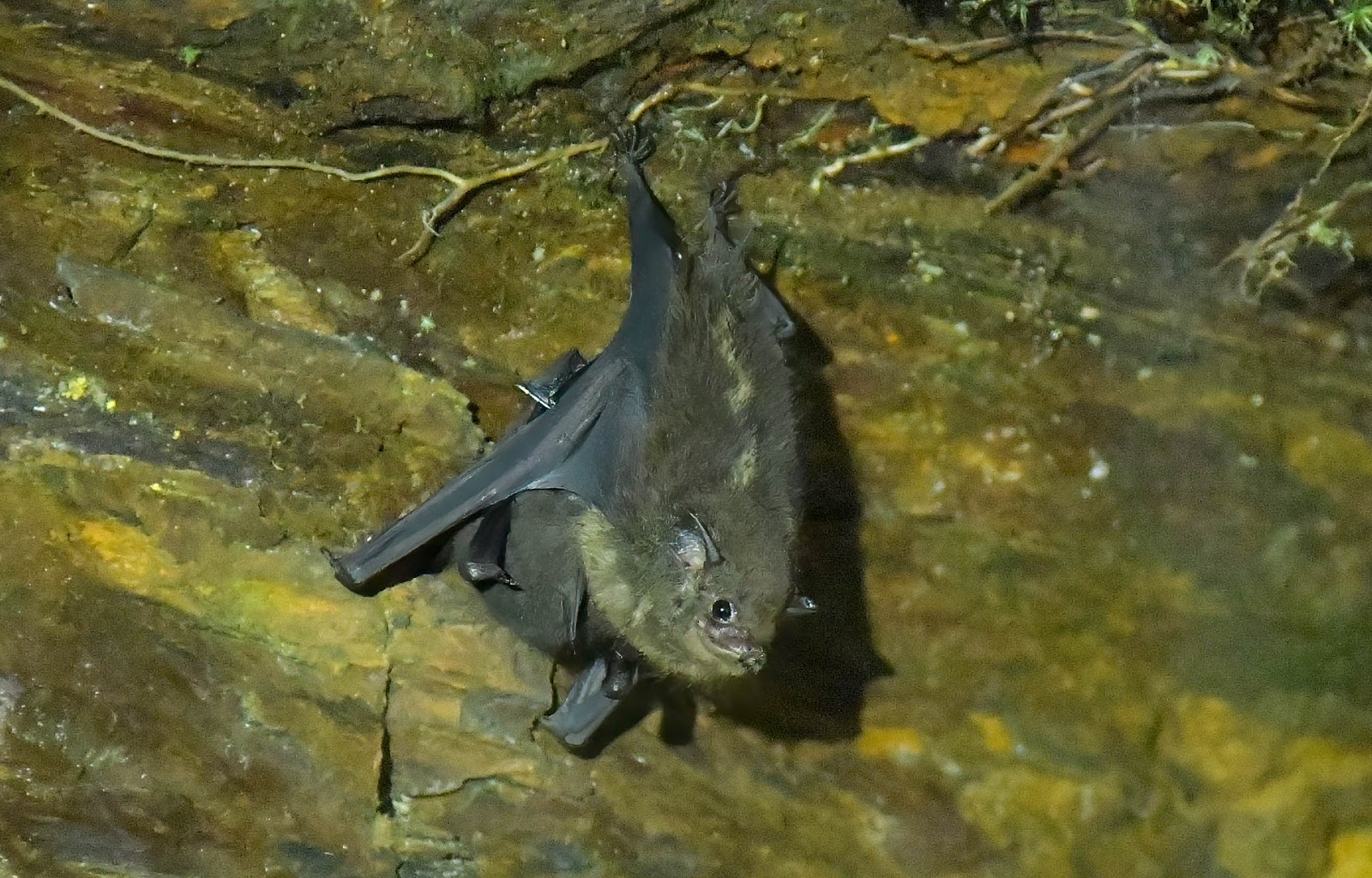 |
| Lesser Sac-winged Bat |
We continued to climb on a steep, slippery ill-defined path that Rob assured us would level out. Just as it did, it began to pour! We rushed to get our pack flies and ponchos on and now had to make the slippery descent in the rain. We got down without incident and returned to the hotel for “easy monkeys”. We hung out in the dining area waiting for Pygmy Marmosets or Ecuadorian Squirrel Monkeys to show up now that we put out bananas for them. The hotel staff kept saying “mañana, mañana”.
 |
| Waiting for Monkeys |
In the morning it was still raining so the “easy monkeys” were a no-show. Finally, the rain let up and we decided to revisit Puway Reserve. We climbed up to the top of the ridge when Rob shouted “wasps, move back!”. Marc was in the back and wasn’t sure what was going on but we ran a safe distance from the wasps. Marc thought Rob was shouting about the titi monkey that Marc had spotted low down in a nearby tree. Edilson and Rob missed it being distracted by the wasps. By the time we had moved around the wasps, the titi had moved high into the canopy and it was hard to tell if it was a Black or Yellow-handed Titi. The trail climbed down, crossed a stream, and reached the now abandoned buildings of the reserve or so we thought. We then heard dogs barking and were greeted by the caretaker. He had decided to stay on all by himself throughout the pandemic to keep an eye on the place. Surprisingly there was a friendly troop of Lesson’s Saddle-back Tamarins in the vicinity, a new species for us!
 |
| Lesson’s Saddle-back Tamarin |
After lunch, we returned to Donde se Oculta el Sol Reserve to look for monkeys along the road. Not long after we started, Rob spotted a Western Pygmy Marmoset high up in a tree, nice find! Edilson was able to relocate it or possibly a second individual and Marc got some photos for identification. This species has recently been split and we were seeing the western species.
 |
| Western Pygmy Marmoset |
We managed to find some Ecuadorian Squirrel Monkeys and Lesson’s Saddle-back Tamarins but the Yellow-handed Titi Monkeys eluded us. At least we had seen them in Ecuador back in 2017.
The next morning the weather had cleared so the “easy monkeys” had no excuse for not showing up. We waited until 8:00 but gave up and went to our room to pack. Just as we were heading out the door, Rob shouted “there are monkeys behind your room!”. A large troop of Ecuadorian Squirrel Monkeys had descended upon the hotel. We followed them to the dining area where they had found the bowl of bananas! It didn’t take them long to devour the entire lot. What’s more fun than a barrel of monkeys? A bowl-full of Ecuadorian Squirrel Monkeys!
 |
| Ecuadorian Squirrel Monkeys |
We drove back through Villagazon before turning off the main highway toward Miraflor, our next destination. We bumped along a dirt track to the Caquetá River. To get to the village, we had to be ferried across the river. We sat in the back of the boat with the local passengers while cargo including 4 motorcycles with their riders was being loaded up front.
 |
| Caquetá River Ferry |
On the other side of the river, we were met by Harold, the owner of the hotel we’d be staying, and Miller, the driver of an old Toyota pickup. The Tursan Hotel looked like a riverboat docked on land and maybe it was.
 |
| The Tursan Hotel |
After settling in, we drove back to town for lunch. While waiting for our guide, Alexis, we watched as a wall of rain approached and engulfed the town. The rain let up so we decided to go to the community forest to look for our main primate target, the critically endangered Caquetá Titi. Alexis caught up to us not long after we set off and we passed a few fincas with grazing herds of Brahma cattle but no primates were seen or heard. Finally, we spotted some Ecuadorian Squirrel Monkeys and Lesson’s Saddleback Tamarins but no titis. We arrived at Alexis’ house where we had a great view of an Ecuadorian Squirrel Monkey in the open.
 |
| Ecuadorian Squirrel Monkey |
On the return, we encountered more squirrel monkeys and tamarins but frustratingly no titis. Rob was confident we’d find them in the morning. We stopped at a street vendor to pick up fried chicken and potatoes for dinner and with a cold can of beer we had a satisfying meal.
 |
| Picking Up Dinner |
When we arrived at the community forest the following morning all was quiet. Without the titis vocalizing, we’d have to find them the hard way. We searched all their known haunts with Alexis but they were nowhere to be found. We took a break for breakfast at Alexis’ house before resuming our search.
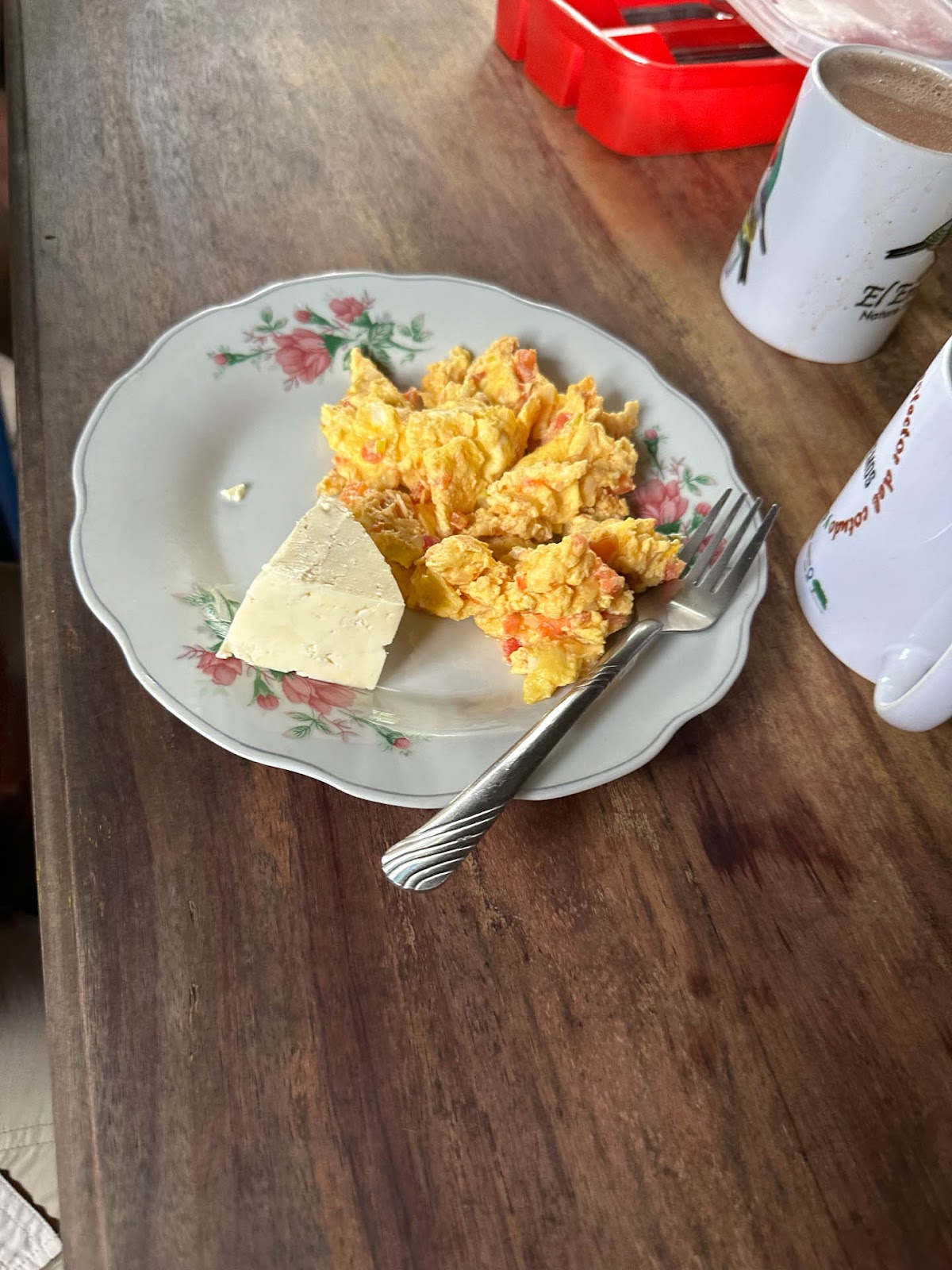 |
| Breakfast at Finca Mirasol |
We ventured off the main path into areas that had once been cleared to grow bananas but the titis weren’t home. We even ventured into Alexis’ family’s organic cacao plantation where we stopped to enjoy some fresh cacao fruit.
 |
| Fresh Cacao Fruit |
After nearly 8 hours of searching, we hadn’t yet seen one monkey! We were about to give up when Alexis returned from a foray in the forest and excitedly reported he had found titis! We followed him to the spot but unfortunately, they had moved off. We searched in vain in the dense vegetation but retreated to the main path empty-handed. They did make another brief appearance and Marc was able to get a glimpse but I wasn’t so lucky. We’d make a last-ditch effort to find them in the morning.
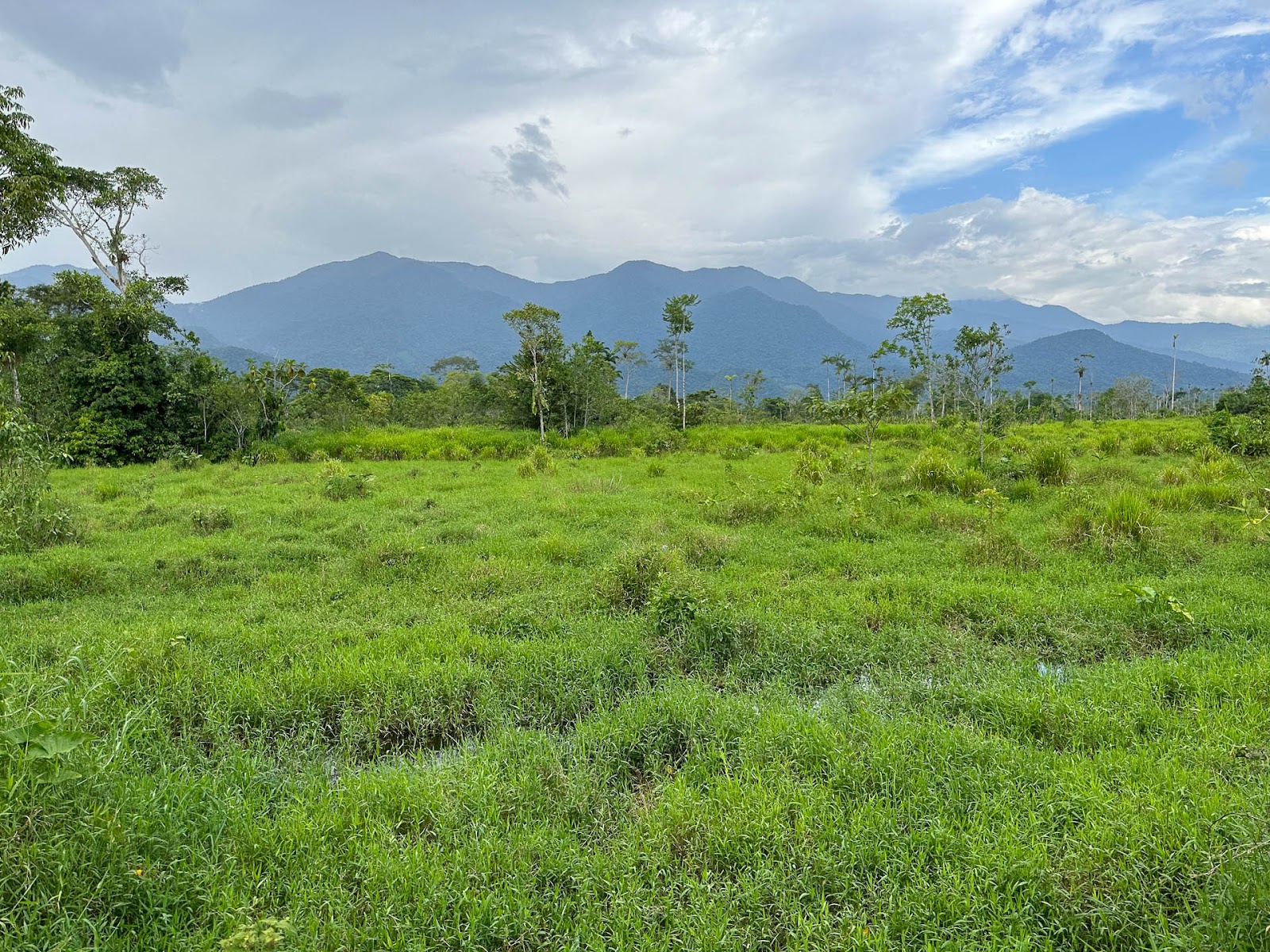 |
| Near Finca Mirasol |
The weather had cleared in the morning and the Caquetá Titi Monkeys were much more vocal. At least we knew what general area they were in but they were too far away. We returned to the area where we had seen the titis yesterday. We could hear them calling so we entered the forest and walked to a cleared cornfield. Here we got our best views and Marc was able to get a photo of the tails of 2 of the 3 titis present. Sadly this would be our best encounter. At least we got a glimpse. With less than 100 remaining, not many people can claim to have seen a Caquetá Titi Monkey in the wild!
 |
| Caquetá Titi Monkey Tail |
We returned to the hotel to pack up for the trip back to Villagazon where we’d catch a flight back to Bogota. Leg 2 of “Mission Monkey” had come to an end. Although more challenging than Leg 1, we did manage to see another 7 species of primates, 3 of which were lifers for us. Stay tuned for our final leg of "Mission Monkey."
We hope all is well with everyone,
Peggy and Marc
Our route map:

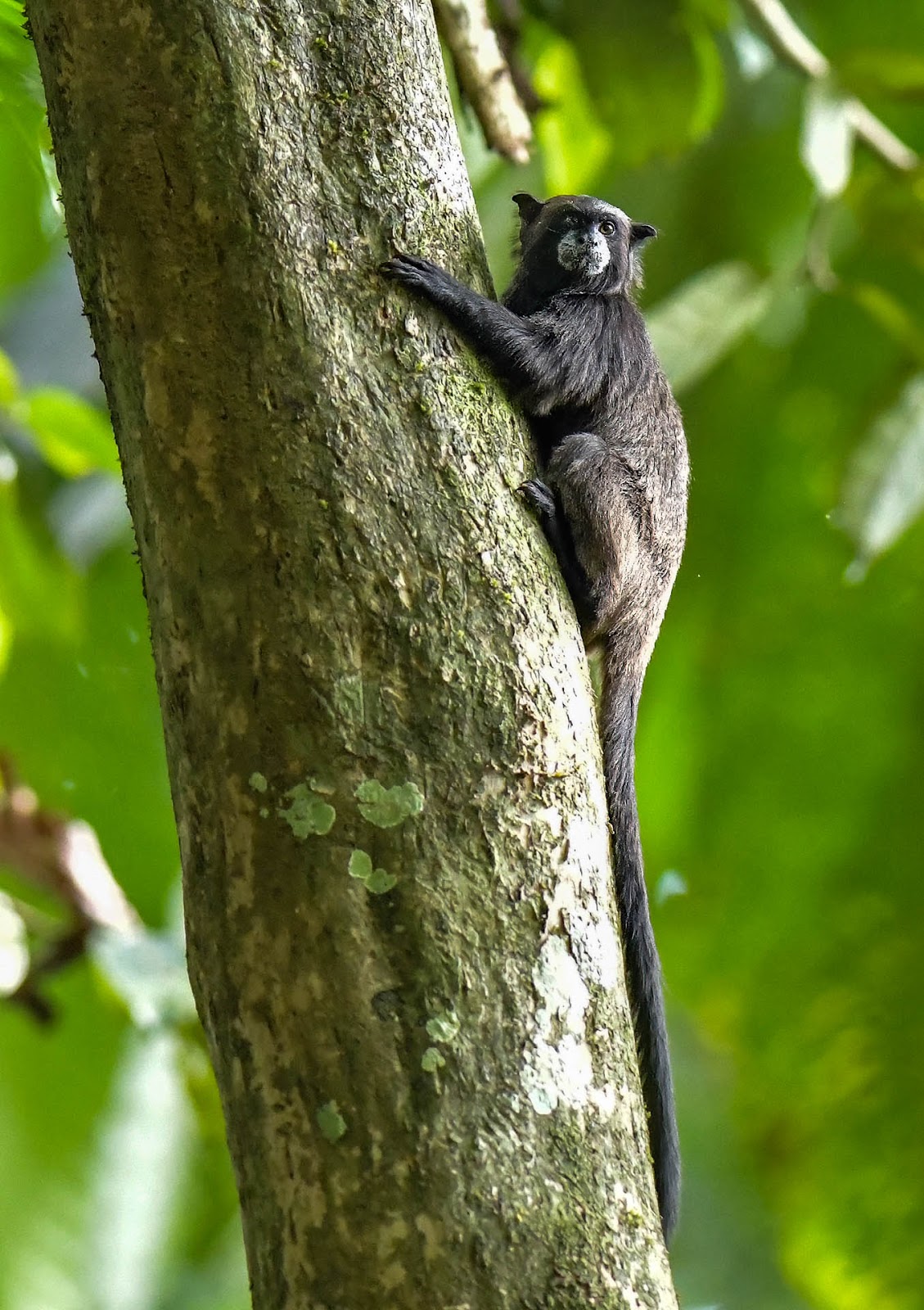
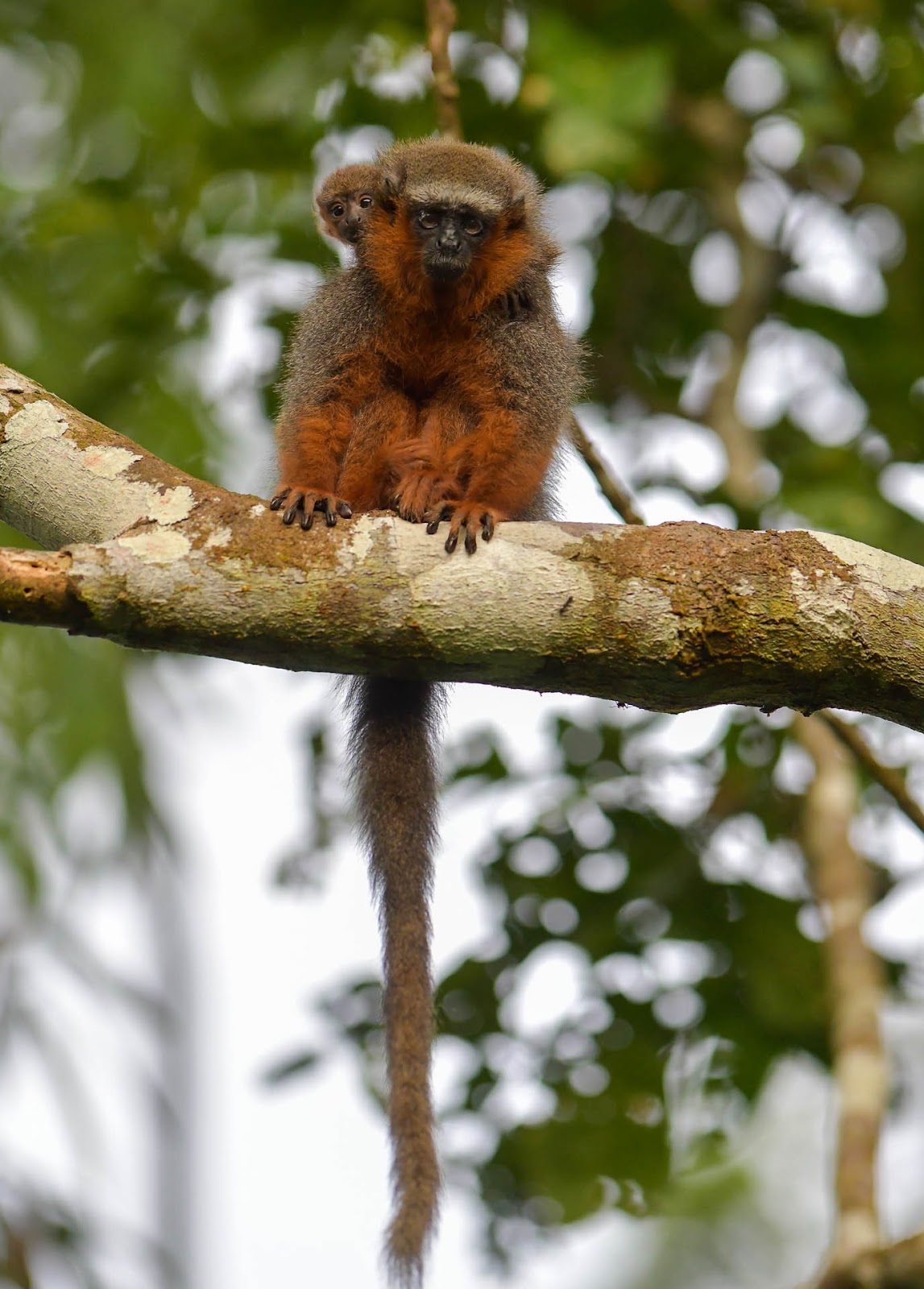


No comments:
Post a Comment